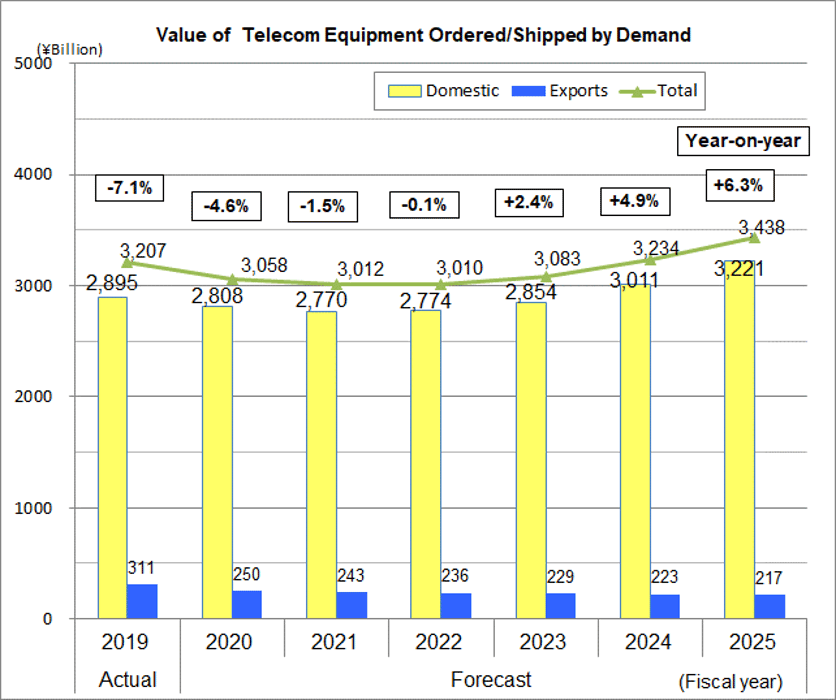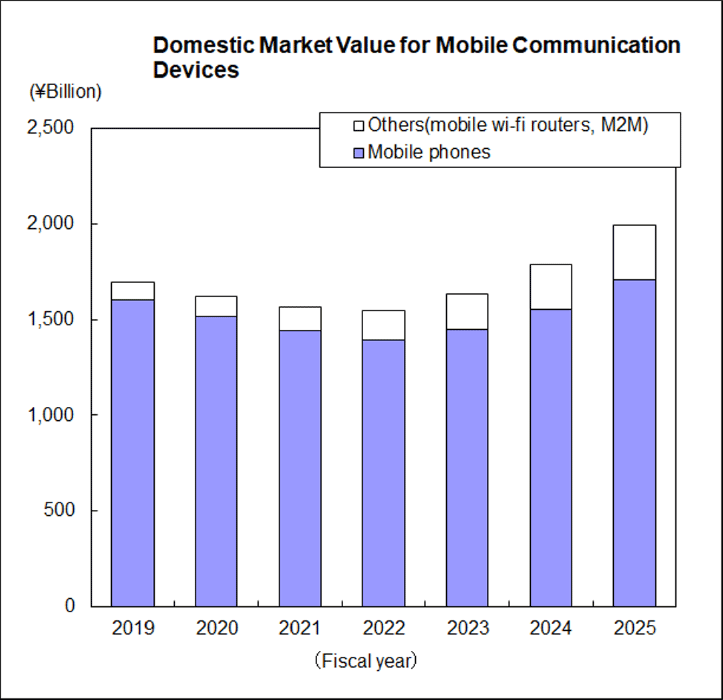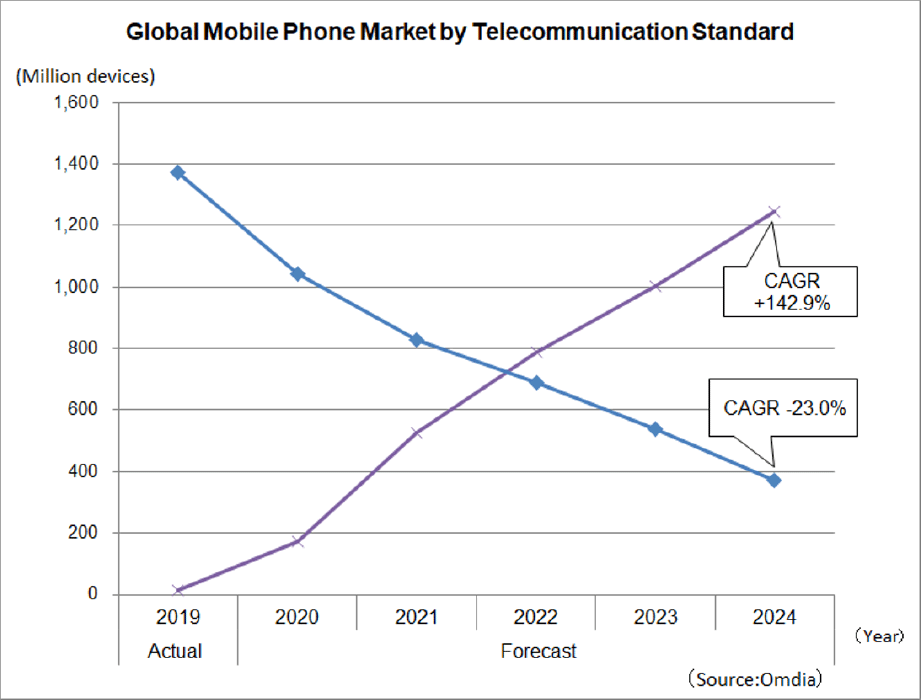The Communications and Information network Association of Japan (CIAJ), a general incorporated association, released its “Mid-Term Demand Forecast for Telecommunication Equipment,” covering FY2020 through FY2025. The report forecasts demand and analyzes technology service trends for communication infrastructure equipment to accommodate explosive network traffic growth and devices compatible with new services which are both associated with the launch of commercial 5th generation mobile communication system (5G) services
I. Outline
The Japanese economy was experiencing a gradual recovery in FY2019, but reversed gear at the end of the fiscal year with the outbreak of COVID-19. Consumer spending shrank with voluntary lockdowns before it had fully recovered from the rise in consumption tax, capital investment in facilities shrank as construction and equipment manufacturing declined in the latter half of the fiscal year and businesses delayed investments and exports declined as the global economy slowed. The telecom equipment market was helped by network facility investments to build domestic 5G infrastructure and nation-wide optic cable networks, but the large bulk of demand is dependent on mobile devices. Although upgrades from feature-phones continue, the spread of COVID-19 has dampened purchasing appetites and withholding upgrades until new 5G devices appear on the market have led to the decline in demand. In addition, the slowdown in the global economy led to a decline in exports for almost all categories, resulting in a forecast for FY2020 of 3.207 trillion yen (-7.1% year-over-year growth).
The Japanese economic growth in FY2020 is likely to slow significantly with consumer spending deterred by apprehension towards possible restrictions placed on economic activity to slow the resurgence of infections and continuing decline in capital expenditure in facilities. Private sector thinktanks project real GDP to be -5.6% for FY2020 as of November. Demand for telecom infrastructure is on the rise, but consumer and business equipment demand has been impacted by COVID-19, which has forced cutbacks in business activities and lowered demand. Thus, the total demand for telecom equipment in FY2020 is forecast at 3.584 trillion yen (-4.6% year-over-year growth).
The ICT industry from FY2021 onwards will contribute to revitalizing the Japanese economy and overcoming social challenges as communication infrastructure continues to be built and strengthened under COVID-19 influences that promote new workstyles, like working from home/remote work and on-line learning, while developing and advancing new technologies and products – including those based on 5G and AI, leading to digital innovation in society. The total market value is expected at 3.438 trillion yen in FY2025, or an increase of 7.2% over the FY2019 figure.
II. 2020 Forecast
The total telecommunication equipment market figure for FY2020 is forecast at approximately 3.584 trillion yen (-4.6% year-over-year growth), with the domestic market accounting for 2.808 trillion yen (-3.0% year-over-year growth), and exports accounting for 250.4 billion yen (-19.6% year-over-year growth).
| FY2020 (expected) (billion yen) | Increase over FY2019 (billion yen) | Growth rate | |
|---|---|---|---|
| Digital transmission equipment | 172.8 | 12.6 | 7.9% |
| Fixed communication equipment | 168.4 | 8.7 | 5.4% |
| Optical access equipment | 25.3 | 2.3 | 10.0% |
| LAN switches | 178.6 | 2.3 | 1.3% |
| Routers | 103.1 | 0 | 0.0% |
(1) Consumer equipment total: 1.667 trillion yen (-5.1% over FY2019)
- Revision of the Telecommunication Business Act in Oct. 2019 capped device discounts at 20,000 yen, resulting in higher price tags for the consumer. In addition, the COVID-19 pandemic reduced purchasing opportunities at brick-and-mortar retailers, replacement cycle of mobile terminals continued to become longer and along with the “wait-and-see” psychology among consumers until new pricing plans and 5G device line-ups are announced all led to decreasing demand.
- Steady demand among older adults for cordless phones and personal facsimiles (including multi-functioning facsimiles) with value-added features, such as easier to see large LCDs, voice communication capacity during black-outs or use of databases to block unwanted telemarketing calls or calls from scam artists will not be enough to reverse the overall downward trend.
(2) Enterprise equipment total: 399.4 billion yen (-14.2% over FY2019)
- Replacements are central to demand for key telephones, PBXs and office-use cordless phones and was already declining as workstyle innovation accelerated by the COVID-19 pandemic decreased use of fixed telephones and businesses decide to minimize office space with more employees working from home.
- Overseas demand takes up a large share for office-use facsimiles (including multi-functioning facsimiles) and with the negative impact of COVID-19 on overseas economies, exports are shrinking dramatically.
(3) Infrastructure equipment total: 525.8 billion yen (+4.1% over FY2019)
- Demand for digital transmission equipment will continue to grow with the realization of nation-wide backbone networks that are 5G-compatible and built on optic cable networks. However, base station demand is expected to remain flat.
- Private sector capital investment in facilities is on the decline, but demand for fixed communication equipment serving as the backbone of disaster/emergency systems is projected to continue to grow.
(4) Internet equipment total: 307.0 billion yen (+1.5% over FY2019)
- The COVID-19 pandemic has translated into an increase in network traffic from such phenomena as more people working from home and doing business via on-line meetings, which in turn is expected to drive healthy demand among telecom carriers and government agencies for routers, LAN switches and optical access equipment.
(5) Equipment/parts categories not included above: 159.5 billion yen (-10.0% over FY2019)
III. Midterm Projection
The FY2025 total figure is projected at 3.438 trillion yen (+7.2% growth over FY2019), with the domestic market accounting for 3.221 trillion yen (+11.3% growth over FY2019) and exports accounting for 216.7 billion yen (-30.4% growth over FY2019).
| FY2025 (expected) (billion yen) | Increase over FY2019 (billion yen) | Growth rate | |
|---|---|---|---|
| Mobile communication terminals (public network use) | 1997.4 | 280.0 | 16.3% |
| Base station equipment | 250.8 | 66.3 | 35.9% |
| Fixed communications equipment | 174.8 | 15.0 | 9.4% |
| LAN switches | 190.5 | 14.2 | 8.1% |
| Digital transmission equipment | 170.5 | 10.2 | 6.4% |
| Optical access equipment | 27.8 | 4.8 | 20.9% |
(1) Consumer equipment total 2.021 trillion yen (+15.1% over FY2019)
- Domestic demand for mobile communication terminals is forecast to show significant growth with new 5G service-compatible devices coming on the market and expansion of IoT leading to greater use of M2M (Machine to Machine) modules.
- The global mobile phone market (includes smartphones) sales revenue in FY2024 is projected at 421.3 billion U.S. dollars (CAGR +3.3%) with the launch of commercial 5G services. Unit sales of smartphones by communication format will decrease in FY2020 with COVID-19, but is forecast to rebound in FY2021 onwards as upgrade demand for 5G handsets grows.
- Although value-added features catering to the needs of older adults will sustain steady demand for certain categories, overall demand for cordless phones and personal facsimiles (including multi-functioning facsimiles) is forecast to continue declining with fewer use cases and more consumers opting not to own devices in this category.
(2) Enterprise equipment total: 337.1 billion yen (-27.6% over FY2019)
- Key telephones, PBXs and office-use cordless phones are forecast to decline as the COVID-19 pandemic fast forwards workstyle innovations, with large corporations leading the way in rebuilding voice communication platforms to create environments to communicate from anywhere, connecting to the cloud and taking advantage of smartphone intra-office apps – all fueling the shift away from land line telephones.
- The domestic market for office-use facsimiles (including multi-functioning facsimiles) will continue to decline with less use as shifts to other communication channels such as e-mail result in longer replacement cycles as well as workstyle innovations require less intra-office paperwork and thus, smaller office spaces.
(3) Infrastructure equipment total: 596.3 billion yen (+18.0% over FY2019)
- The surge for network digital transmission equipment and terrestrial fixed communication devices to accommodate the spike in data traffic from the COVID-19 pandemic (i.e., telework) is expected to reach the end of its demand cycle, while services which take advantage of 5G features – high speed & high capacity, simultaneous high-density connections with low latency – will lead to a significant investment growth in base stations from FY2022 onwards.
- Public sector demand for satellite fixed communication equipment will remain steady with planned satellite launches.
(4) Internet equipment total: 320.5 billion yen (+6.0% over FY2019)
- Demand for routers is forecast to slightly decrease as the market shrinks. Positive factors include investments in laying down 5G networks, further progress towards digitalization and workstyle transformation fueled by COVID-19 as well as upgrading and expanding facilities in order to accommodate faster speeds and advanced security features. However, these will be outweighed by negative factors, including lower unit prices from fierce price competition, streamlining of equipment and virtualization making use of general-purpose servers.
- The demand for LAN switches is forecast to increase in value as the embracing of IoT/M2M technologies will result in massive increases in the number of devices connected to the network, meaning a surge in network traffic and investments in carrier facilities and data centers. Commercial 5G services will also translate into additional facilities and replacement demand.
- Increased use of high-speed services to facilitate growing demand for data-heavy contents, such as video services, growing popularity of smartphone video apps leading to mobile data offloading as well as replacement of outdated equipment are expected to increase the market value for optical access equipment.
(5) Equipment/parts categories not included above: 162.9 billion yen (-8.1% over FY2019)
IV. Trends in the Info-Communication Industry Market
(1) Trends in 5G and local 5G
- Government authorities are approving 4G frequency bandwidth to be diverted to 5G so that 4G base stations can be used to expand 5G coverage and telecom carriers are implementing open network technologies for base stations (O-RAN Alliance).
(2) Latest IOWN trends
- The Innovative Optical and Wireless Network (IOWN) was announced as a networks and information processing infrastructure including terminals that can provide high speed/large capacity communications utilizing innovative technology focused on optics as well as tremendous computational resources to exceed the limits of existing infrastructure. The specs will be finalized in 2024 and aim for realization in 2030.
- IOWN is basically composed of 3 technological areas: “all-photonics network,” “digital twin computing,” and “cognitive foundation.”
(3) Use of ICT in the post COVID-19 era
- The COVID-19 pandemic has fundamentally changed peoples’ work and lifestyles. Avoiding closed spaces, crowded places, and close-contact settings with others is essential to controlling the spread of the virus. Active use of ICT has been promoted in “work & lifestyles,” “industry and enterprises,” and “governments.”
[Forecasting methodology]
Domestic market forecasts are based on statistics compiled by CIAJ and interviews with CIAJ members, with the cooperation of InfoCom Research, Incorporated, for areas not covered by CIAJ.
Global ICT market forecasts and demand trends refer to and utilize data and analysis provided by a global research company Omdia with the cooperation of InfoCom Research, Incorporated.



